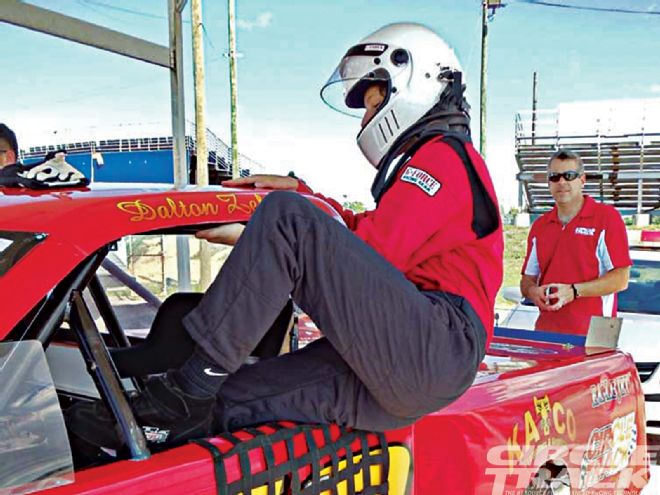
Be sure to check out the video at the end of our article: "5 Key Safety Items for your Kid Racer"
There is a young lady who works at Circle Track's main office who grew up at the local dirt track here in Tampa. She now has a young son who absolutely loves short track racing. Four-year-old Landon can routinely be found in the pits helping out under the watchful eye of his mother, Jessica. Landon's dad doesn't race himself but the whole family works on an uncle's Dirt Modified. Obviously, little Landon is destined to climb behind the wheel someday. When he does slip into a fullsized car 10 years or so down the road his parents will have a world of safety options that we can only dream of today.
But what if your kid is getting into racing now? What are your options to keep him or her as safe as you can? With that in mind, let's take a look at some of the most important items they'll need. We're going to save car construction, seat mounting and things like that for another article. This month we are going to deal with what they'll need as a first time racer in today's market.
Helmet
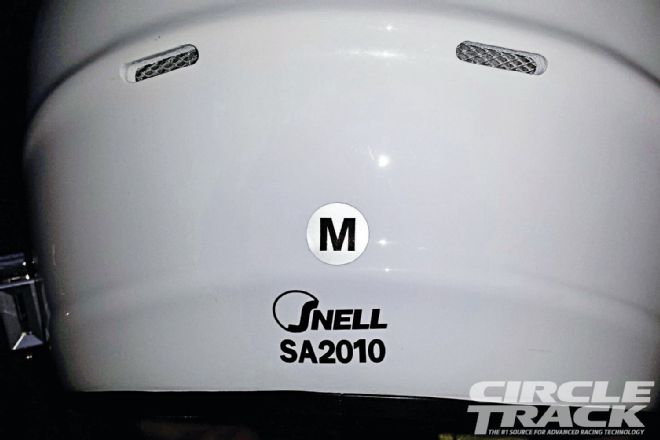 This is what a Snell SA2010 rating decal looks like on the back of a G-Force Racing Gear Pro Eliminator helmet.
This is what a Snell SA2010 rating decal looks like on the back of a G-Force Racing Gear Pro Eliminator helmet.
There is not a racetrack in the country that will let you compete without a helmet. However, there are some key things about helmets that you must know in order to keep that tikes melon in one piece. First off, the only helmet you should buy is one that carries a Snell SA2010 rating. If it doesn't carry that rating it is not designed for car racing...plain and simple. On a not so recent trip to a local short track, we actually saw a 15 year old sporting a full faced BMX style bicycle helmet as he sat behind the wheel of a Street Stock. When we confronted the parents they saw nothing wrong with it due to their lack of knowledge of the rating systems and testing procedures. A helmet is a helmet they thought. It wasn't their fault, they just didn't know.
So why is SA2010 the standard to look for? First off as we mentioned SA is the identifier for a helmet that has been designed for car racing. It has to pass a series of stringent tests conducted by the Snell Foundation to gain the designation, including but not limited to a flammability test; point impact chin bar test; point impact visor test and more. Other helmets (motorcycle, bike, and more) are not subjected to these tests. They have to pass a different set of tests tailored to the respective sport.
Now if you think about accidents you see on a racetrack...there can be fire and there can be sharp heavy objects flying around at a good rate of speed. The only way to give your driver the best chance of survival when things go wrong is to have the best equipment. You should also note that the SA2010 is the latest rating as the Snell Foundation changed their testing procedures in 2010, making them more difficult to pass than the old SA2005 rating, meaning your SA2010 rated helmets are safer.
Head-and-Neck Restraints
Last year, 12-year-old Tyler Morr died from injuries sustained in a crash at Auburndale Speedway in Florida. He was driving in the Kids Club race. He was not wearing a head-and-neck restraint. Had he been wearing one, he most likely would have survived. Those are sobering words to have to write. But it is something that every racing parent needs to hear.
Everybody who works on this magazine holds the same opinion when it comes to head-and-neck restraints. Wear one or don't race. But when kids are the ones racing Circle Track magazine's official position is that a HNR is the first piece of safety equipment you, as a parent, should purchase. Save up for it before your child ever turns a single lap of practice.
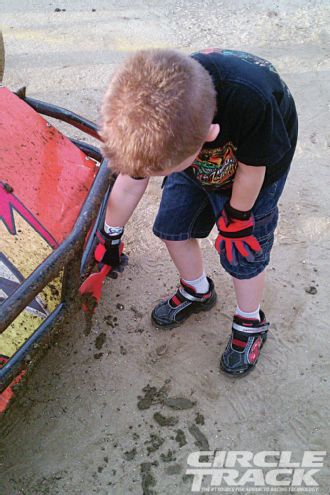 Little Landon King helps scrape mud off of his Uncle Bobby Dixon’s race car at East Bay Raceway Park in Tampa, Florida.
Little Landon King helps scrape mud off of his Uncle Bobby Dixon’s race car at East Bay Raceway Park in Tampa, Florida.
Like all of the safety equipment we're talking about in this article head and neck restraints fall under a set of specifications that are administered by the SFI Foundation (SFI). This non-profit organization was established to administer standards for the quality assurance of specialty performance and racing equipment such as firesuits, seatbelts, etc. The SFI Spec for head and neck restraints is 38.1 and will appear on the actual restraint (along with a date of manufacture) somewhere on the unit. Currently, there are two producers of head and neck restraints; Simpson (HANS and Hybrid brands) and NecksGen. Each of the three brands have passed SFI's testing and carry the SFI 38.1 Spec. So any of them would be a good choice. Do you homework on the features and costs and how each one would fit into your racing budget. Most importantly make sure that the fit is correct for your young racer. There are units available for children as well as adults, but don't just assume that because your child doesn't have a driver's license that he or she need the kids size. Some kids, like the 15-year-old pictured on this page, have shoulders broad enough to use an adult device.
We'll have more valuable information on head and neck restraints in a coming issue, but for now it is on to our number three item.
Firesuit
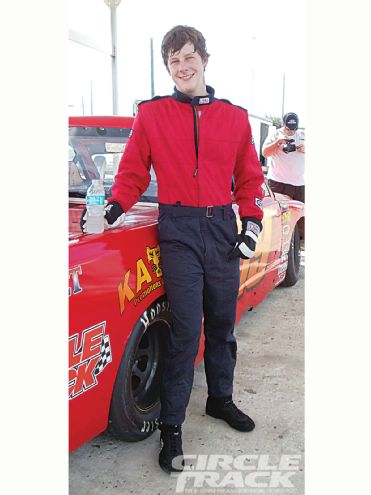 This young racer has all the right equipment. His gear includes G-Force’s GF525 single piece suit, an SFI 3.2/5 rated two layer setup with a TPP of 21; SFI 3.3/5 rated premium gloves and SFI 3.3/5 rated shoes. His helmet (not pictured) carries the SA2010 rating and he opts for a NecksGen head-and-neck restraint.
This young racer has all the right equipment. His gear includes G-Force’s GF525 single piece suit, an SFI 3.2/5 rated two layer setup with a TPP of 21; SFI 3.3/5 rated premium gloves and SFI 3.3/5 rated shoes. His helmet (not pictured) carries the SA2010 rating and he opts for a NecksGen head-and-neck restraint.
We know that you know that you need a firesuit to go along with your helmet. But when you're talking about kids in racing there are some additional considerations you need to take into account. First off kids do one things that adults don't. They grow...a lot. With that in mind it can be tempting to buy a cheap firesuit, knowing that he or she could start the season in a small and end it in a medium.
At this point let's refer to the chart above titled TPP vs. Second Degree Burns. SFI's rating designation for firesuits is 3.2A which is followed by a number (1, 5, 10, and so on). The number rating corresponds to the suits TPP value or how well the suit protects you from fire. For our purposes in this discussion the third column in that chart is the critical one. That column shows you how much time your kid will have to get out of the race car if it is on fire and that fire has already come in contact with their suit.
Now before you go out and buy a $2,000 Top Fuel/Funny Car suit, let's go back to what started this commentary. Kids grow and racing is expensive. A good two layer SFI rated suit will run between $300 and $400. Now compare that to a single layer, economy suit for $80. The single layer is much more budget friendly but look at the chart, it yields a much lower time to second-degree burn.
TPP vs. Second-Degree Burns SFI rating TPP values Time to second-degree burns Typical use 3.2A/1 6 3 seconds Single-layer suit; entry-level 3.2A/5 19 9 seconds Double-layer driving suit 3.2A/10 38 19 seconds Land speed records 3.2A/15 60 30 seconds Top Fuel alcohol drag suit 3.2A/20 80 40 seconds Top Fuel alcohol Funny Car suit
Cheap Insurance
Now by adding fire retardant underwear into the mix you can up your protection factor while keeping the expenditure in check. FR undies cost about $75 for a top and in most cases the same amount for the bottoms. Obviously if your budget allows we always recommend at minimum a two layer suit.
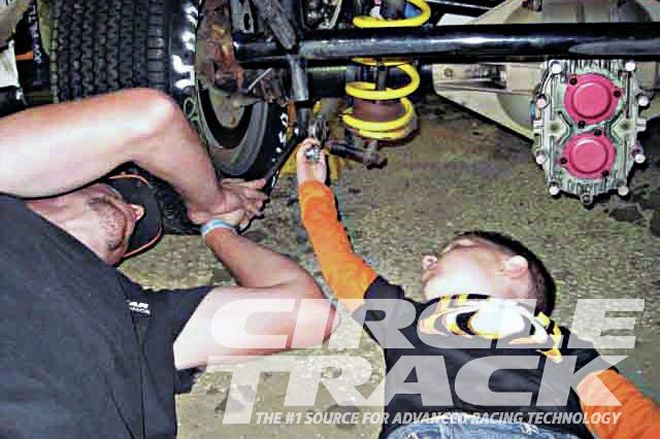 If you’re going to let you child work with you under a race car (your choice), be sure to take the proper safety precautions. You can just see the yellow jackstand behind Landon’s hand in this picture.
If you’re going to let you child work with you under a race car (your choice), be sure to take the proper safety precautions. You can just see the yellow jackstand behind Landon’s hand in this picture.
Gloves
In that same scenario you are going to need a stout pair of FR gloves to keep your hands functional so that you can unbuckle, pull the window net down and get out of the car. Here is where we definitely recommend SFI 3.3/5 rated premium gloves, even if you're going the single layer plus fire retardant underwear route. In the event of a fire you're going need as much protection on your hands as possible in order to unbuckle, pull the window net down and get out of the car. Gloves should fit nice and snug around all the fingers.
Shoes
Now just because you've got the best gloves and a nice two layer suit or even a single layer suit with proper underwear for your son or daughter don't forget their feet. In the event of a fire, often times you will have flames come through the firewall into the cockpit. When that happens the first things to get really toasty are your feet. So a good pair of fire retardant shoes are a necessity.
One more comment about shoes, get your young racer into the habit of cleaning off the soles of their shoes as one of the last things they do before getting in the you're your feet control the throttle and braking of the car and obstructions on any part of them can cause issues, bad issues, once on the track.
The Seat
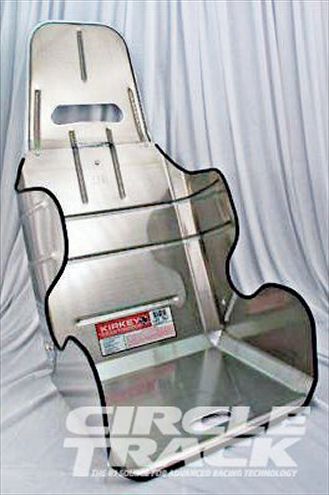 This is roughly a $100 racing seat designed for Street Stocks according to the manufacturer. Compare it’s safety features to the other seats in this story.
This is roughly a $100 racing seat designed for Street Stocks according to the manufacturer. Compare it’s safety features to the other seats in this story.
Good safety practices don't just start and stop with what you or your child wear. One of the best ways to stay safe inside the car is to have the proper seat. Seats can be had for under $150 but a cheap seat in the wrong application can yield disastrous results. The aforementioned young racer who tragically lost his life was not in a full containment seat. Our philosophy when it comes to seats is much the same as you've heard through this article, overkill is not necessarily a bad thing. Why not mount a full containment seat in a Mini-Stock? I've seen those cars flip and if you've been around racing for any period of time I bet you have too.
After the tragic loss of Jason Leffler in a Sprint Car accident earlier this year we had a discussion with Gary Milgrom, Vice President of HANS Performance Products. Engineers from HANS were involved in the inspection of the car after the crash and learned valuable information about cockpit safety. Leffler was wearing a head-and-neck restraint at the time of the accident but as it turns out that is merely one piece of the puzzle as Milgrom notes.
"From all sources of information now available to us, and after inspecting the car, we think Jason would have had a better chance with a full containment seat, including a proper head surround and left side net," said Milgrom.
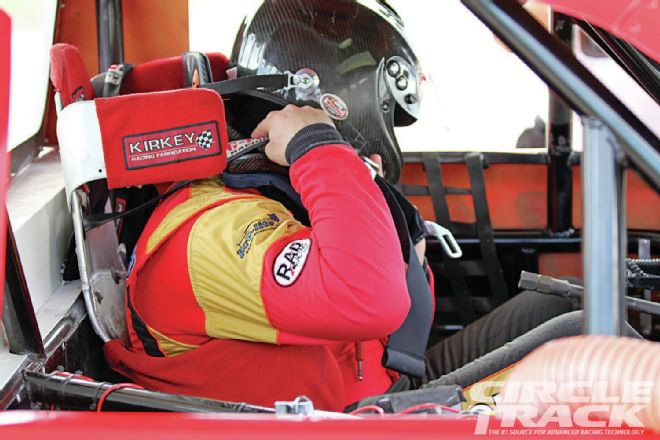 This is a full containment seat but it is an older model. Note that the head surrounds is present but it is a relatively thin piece of aluminum. The seat does have decent rib supports but it lacks additional gusseting and shoulder supports found in newer models.
This is a full containment seat but it is an older model. Note that the head surrounds is present but it is a relatively thin piece of aluminum. The seat does have decent rib supports but it lacks additional gusseting and shoulder supports found in newer models.
But what he said next really resonated with us, "Cockpit safety requires a complete system of equipment. Along with Head-and-neck Restraints for frontal impacts and those offset by 30 degrees, cockpits in all race cars need full containment seats, including head surrounds and side nets, and at least 6 point safety harnesses with the proper mounting."
Real Insurance
Insurance is likely the most important piece of safety equipment that many racers don't even know about. To get the low down on what parents should consider when it comes to insurance we tracked down Dennis Huth, President of ASA and asked him to shed some light on the insurance puzzle.
"When it comes to the insurance side of things in motorsports, I have always believed that a good insurance policy should be in effect," said Huth. "From my days at NASCAR, Trans-Am, and IMSA to the present days here at ASA, I believe safety is a key component and should be synonymous with any racing activity. Beyond that, knowing that motorsports is a dangerous sport, insurance should be in place for those times when safety gives way to injury."
Working with Jeff Ladd, President at SIS Insurance and Don DeWitt, Senior VP for Underwriters ASA has been able to craft one of the best sanction-provided insurance policies around.
"At ASA, we look for the best polices, brokers and underwriters we can find with a strong policy and affordability in mind," says Huth.
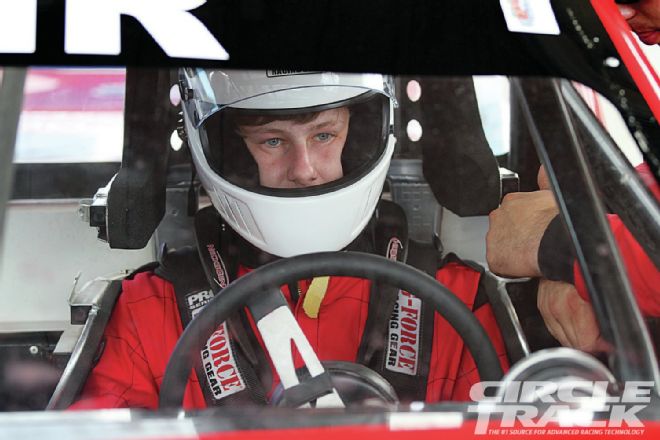 This is a full containment seat. Notice the heft of the head surround and the fact that the seat has shoulder supports. These supports are also padded and have additional gusseting supporting their structure. Although you cannot see it in this picture this seat also has rib supports like the older model on the previous page. Unlike the older model the rib supports have additional gusseting as well.
This is a full containment seat. Notice the heft of the head surround and the fact that the seat has shoulder supports. These supports are also padded and have additional gusseting supporting their structure. Although you cannot see it in this picture this seat also has rib supports like the older model on the previous page. Unlike the older model the rib supports have additional gusseting as well.
At the heart of that coverage is a $500,000 Personal Participant Medical Plan for racers who hold an ASA license, are racing in an ASA sanctioned event and are 14 years old or older. For racers under 14 ASA offers a $50,000 coverage plan, both of which are top of the line. Through the broker, ASA also offers something they call the "Competitive Advantage Program' which is good all year at any track. Believe it or not, ASA even offers healthcare coverage.
Huth's advice for new racing parents? "I wholeheartedly recommend that anyone racing check with the track to see what their policies and limits are before competing. We at ASA supply the tracks with signage they are to place at the sign-in gate that describes coverages in place that night. Plus, SIS also has a policy that can be purchased that is good for competitors going from track to track in case of some tracks that don't carry larger policies."
After talking with Huth, we developed a bullet point list of what you need to consider no matter where you race:
Conclusion
Strapping your kid into a race car to either follow in your footsteps or forge their own path can be an exciting time both for racer and parent. To make sure that excitement and enjoyment are there week after week pay particular attention to these eight items as your starting point. Naturally this is just the tip of the iceberg, next month we're going to delve into how to bring you young racer along as we feature a pair of teens, one with some experience and one with none as they strap into a current champions first race car.